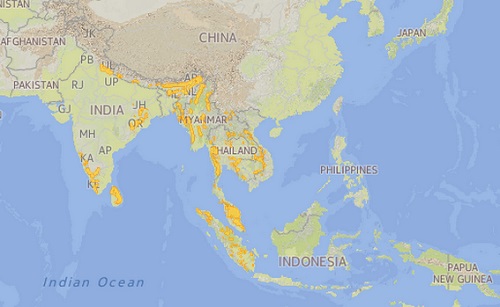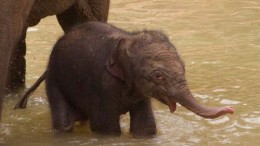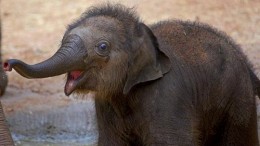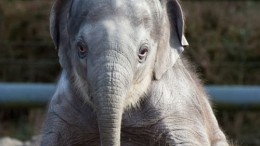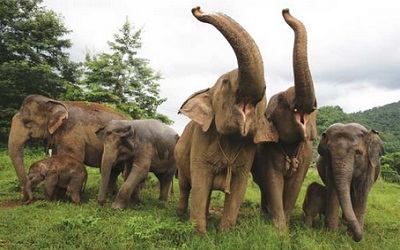
A herd of Asian elephants from the Elephant Nature Park in Thailand. This species is considered “endangered” by the IUCN Red List of Threatened Species.
o
o
Conservation Status
- The Asian elephant is listed under Appendix I of CITES.
- The Asian elephant is listed as “endangered’ in the IUCN Red List of Threatened Species. Its population has declined by more than 50% over the last 45 years.
- The subspecies Sumatran elephant (Elephas maximus sumatranus) is listed as “critically endangered”. It has experienced a population decline of over 69% over the past 25 years.
Physical Features
- The Asian elephant is the largest land mammal in Asia.
- It is smaller than the African elephant and can be distinguished by the smaller size of their ears, rounded or convex back and smoother skin.
- Its trunk or proboscis has a single finger-like extension as opposed to the African elephant that has two. It is an organ used for smelling, sound production, communicating and touching. The trunk contains as many as 150,000 muscle units.
- The trunk serves to transfer water to the mouth and not as a straw. It is also a tool for lifting food and spraying water.
- Their ears are used for thermoregulation. They flap their ears to lower their body temperature.
- Their tusks are overgrown incisors teeth growing from the upper jaw that can reach up to 5 ft or 1.5 m long. They are smaller in Asian elephants and most of the time it is not present in females. Some males and most females grow tushes instead which are smaller tusks.
- Asian elephants are usually gray. The Sumatran species is lighter gray and the Sri Lankan is darker with a distinct depigmentation.
- Even though their skin is thick and has a rough texture it is very sensitive and need to bathe in mud to protect against the sun and insect bites.
- They have long soft hair around the ear openings and lower lip as well as small hairs on the trunk.
- They have 26 teeth and 6 sets of molars during a lifetime. Molars do not grow vertically as in most mammals but they develop horizontally from behind pushing the old worn out molar forward and out
Height and Weight
- Asian elephants measure from 7 to 11 ft or 2 to 3.5 m tall.
- They weigh from 6,600 to 11,000 lbs or 3,000 to 5,000 kg.
Distribution and Habitat
- Its distribution includes the countries of India, Nepal, Bhutan and Bangladesh in the Indian subcontinent; China, Myanmar, Thailand, Cambodia, Laos, Vietnam and Malaysia in Southeast Asia; and the Asian islands of Sri Lanka, Sumatra and Borneo. This represents 15% of its historic range.
- India has 60% of the remaining wild populations.
- Asian elephants live in a wide variety of habitats which include tropical and subtropical forests, grasslands, deciduous woodlands and marshes.
Behavior
- There is no evidence that elephants are territorial.
- Their home range is similar to the African elephant approximately 14 to 52 sq km.
- Elephants are highly social animals that live in complex societies.
- They live in herds of 8 to 12 individuals headed by a matriarch, typically the eldest female. African elephants herds range from 10 to 20 individuals.
- Herds are composed of related females and their calves. Males leave the herd when they are around 12 to 15 years old and live alone or in bachelor herds.
- They communicate by visual, tactile, olfactory and vocal cues.
- They sleep from 3 to 4 hours a day and spend 16 hours a day eating.
Reproduction
- Both bulls and cows reach reproductive maturity between the ages of 14 and 15.
- Mating occurs at any time of the year and may peak during the rainy season.
- Females give birth every 3 to 5 years depending on nutrition.
- Gestation is 22 months, the longest gestation of any mammal.
- Litter size is 1 very rarely 2. They are born with a weigh of up to 250 lbs or 115 kg.
- All females share the care of calves, there is no paternal involvement.
Diet
- Asian elephants are herbivorous and are both browsers and grassers.
- They feed mostly on browse plants during the dry season and grass during the wet season.
- They consume up to 330 lb or 150 kg of food a day.
Life Expectancy
- Asian elephants live 60 to 70 years in captivity and an average of 80 years in captivity.
Threats
- Increasing conflict with humans sharing their habitat.
- Poaching for ivory trade but to a much less extent than the African elephant.
- Calves are prey to lions, tigers and hyenas.
- Drought
- Starvation in old age due to lack of teeth.
Did you know?
- Asian elephants have been domesticated since the Bronze Age by the Indus Valley Civilization.
- The Asian elephant symbolizes the Indian culture and is closely related with religion, history and myths.
- Asian elephants have been used in wars. The first recorded military use was in 326 B.C. in the battle between Alexander the Great and King Porus. They were also used in World War II.
Taxonomy
- Kingdom:Animalia
- Phylum: Chordata
- Class: Mammalia
- Order: Proboscidea
- Family: Elephantidae
- Genus: Elephas
- Species: Elephas maximus
- Subspecies: E. m. maximus – Sri Lankan Asian elephant
- Subspecies: E. m. indicus –mainland Asian elephant
- Subspecies: E. m. sumatranus – Sumatran Asian elephant
References and further research
San Diego Zoo Library – Asian elephant, Elephas maximus
IUCN Red List of Threatened Species – Elephas maximus
Smithsonian National Zoological Park – Asian elephants
International Elephant Foundation
Natural History Museum – Elephas maximus
The Animal Aging and Longevity Database – An age entry for Elephas maximus
The American Society of Mammalogists – Elephas maximus

